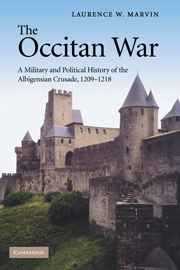Book contents
- Frontmatter
- Contents
- List of abbreviations
- List of maps and plans
- Translation of names and places; calculation of distances
- Preface and acknowledgments
- Maps and plans
- 1 Introduction
- 2 The campaign of 1209
- 3 Simon of Montfort and the campaign of 1210
- 4 The campaigns of 1211
- 5 Drawing the noose: the campaign year of 1212
- 6 The athlete of Christ triumphs: late 1212 through Muret 1213
- 7 From Muret to Casseneuil: September 1213 to December 1214
- 8 The two councils and Prince Louis's crusade, January–December 1215
- 9 The southern counter-attack begins: February 1216 to fall 1217
- 10 The second siege of Toulouse and end of the chief crusader: 1217–1218
- Aftermath and epilogue
- Select bibliography
- Index
5 - Drawing the noose: the campaign year of 1212
Published online by Cambridge University Press: 18 July 2009
- Frontmatter
- Contents
- List of abbreviations
- List of maps and plans
- Translation of names and places; calculation of distances
- Preface and acknowledgments
- Maps and plans
- 1 Introduction
- 2 The campaign of 1209
- 3 Simon of Montfort and the campaign of 1210
- 4 The campaigns of 1211
- 5 Drawing the noose: the campaign year of 1212
- 6 The athlete of Christ triumphs: late 1212 through Muret 1213
- 7 From Muret to Casseneuil: September 1213 to December 1214
- 8 The two councils and Prince Louis's crusade, January–December 1215
- 9 The southern counter-attack begins: February 1216 to fall 1217
- 10 The second siege of Toulouse and end of the chief crusader: 1217–1218
- Aftermath and epilogue
- Select bibliography
- Index
Summary
It becomes increasingly obvious by this stage of the war that rooting out Catharism was secondary to taking territory and eradicating those who defied the chief crusader. The coming year enhanced Simon of Montfort's reputation as a clever soldier but not as a Christian prince. Militarily, not only did Montfort regain territory the crusade had lost the previous fall and winter, but he also went on the offensive in two areas that had never been part of the original mandate for the destruction of heresy: the Agenais and Gascony. To get there, however, he had to strengthen his position in the viscounty of Albi.
Continuing the campaign of 1211 into January 1212, the truncated winter army rode north to attack the small village of Touelles in the Albi region, partly because it belonged to the traitor Giraud of Pépieux's father. Montfort seized the town quickly and executed many of its defenders but took Giraud's father prisoner, exchanging him for Dreux of Compans, a crusader noble captured not long before in a supply train ambush. After this the army besieged Cahuzac, also in the Albi region. Montfort intended to isolate the larger castrum of Gaillac, some of whose citizens had participated in the assassination of Pons of Beaumont, the garrison commander at Lagrave, the previous fall. Because of the severe weather, after a short blockade of two days Montfort had his men assault Cahuzac rather than continue to besiege it.
- Type
- Chapter
- Information
- The Occitan WarA Military and Political History of the Albigensian Crusade, 1209–1218, pp. 132 - 157Publisher: Cambridge University PressPrint publication year: 2008



